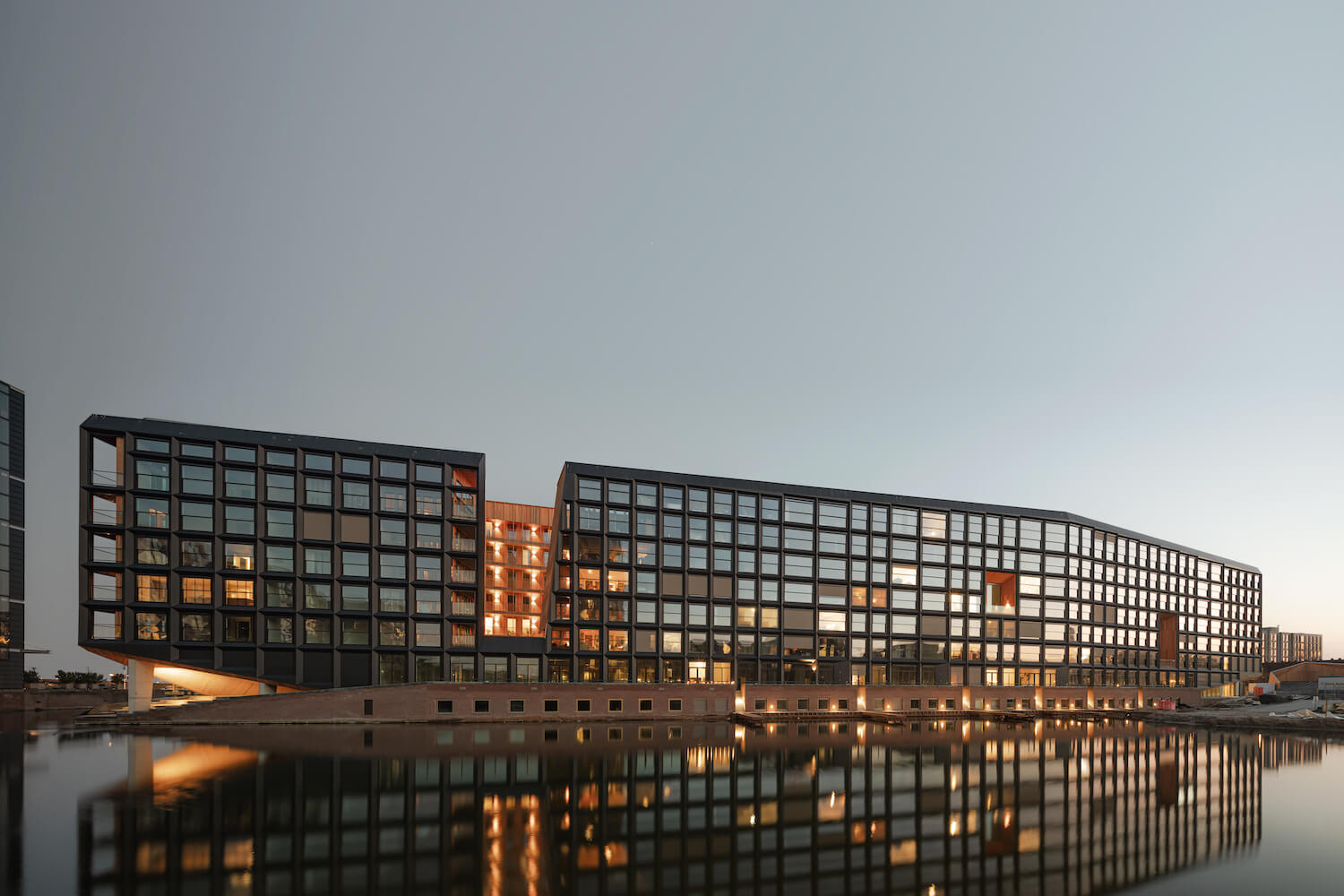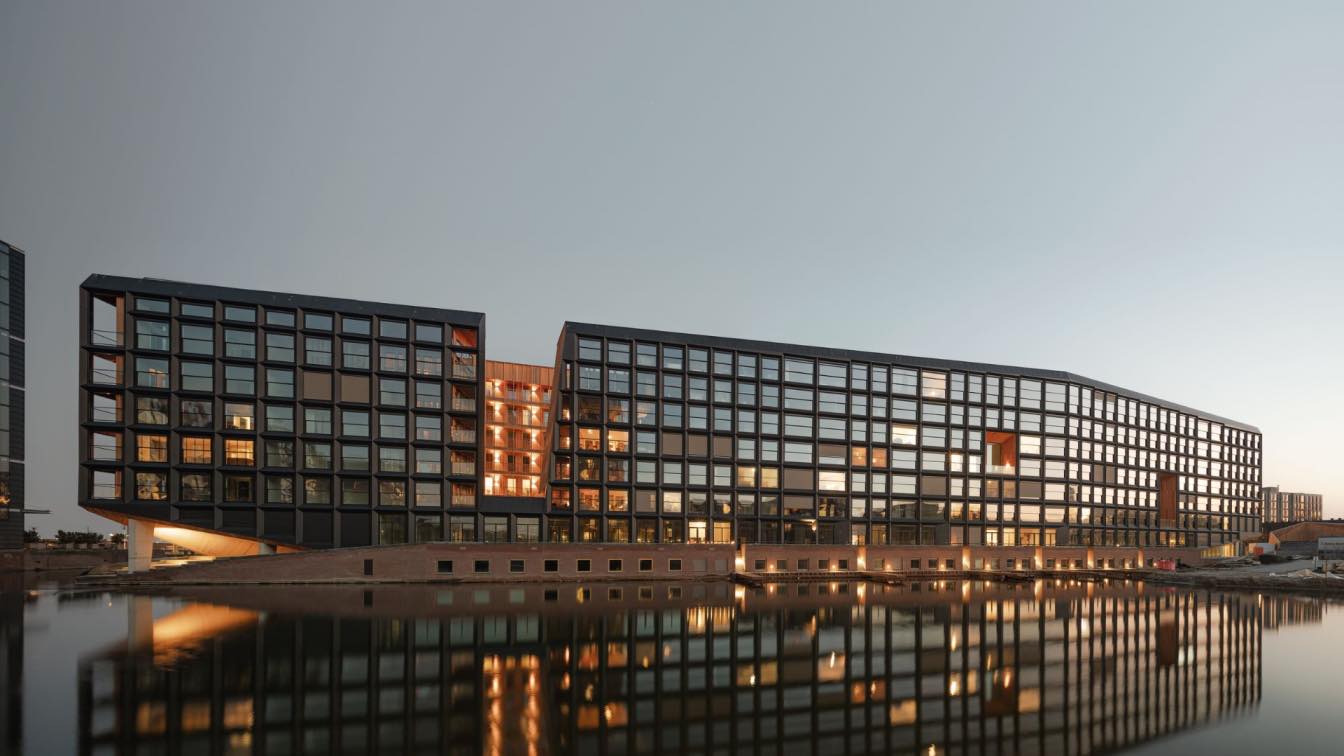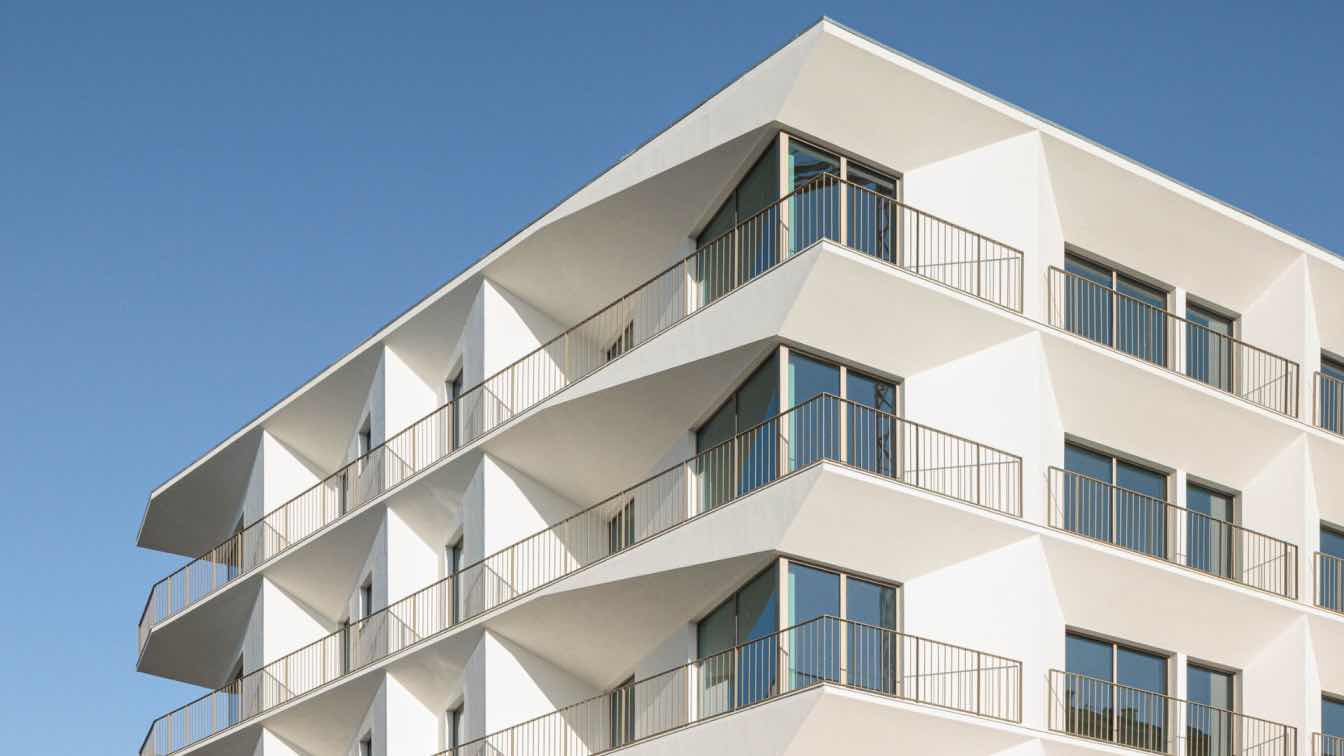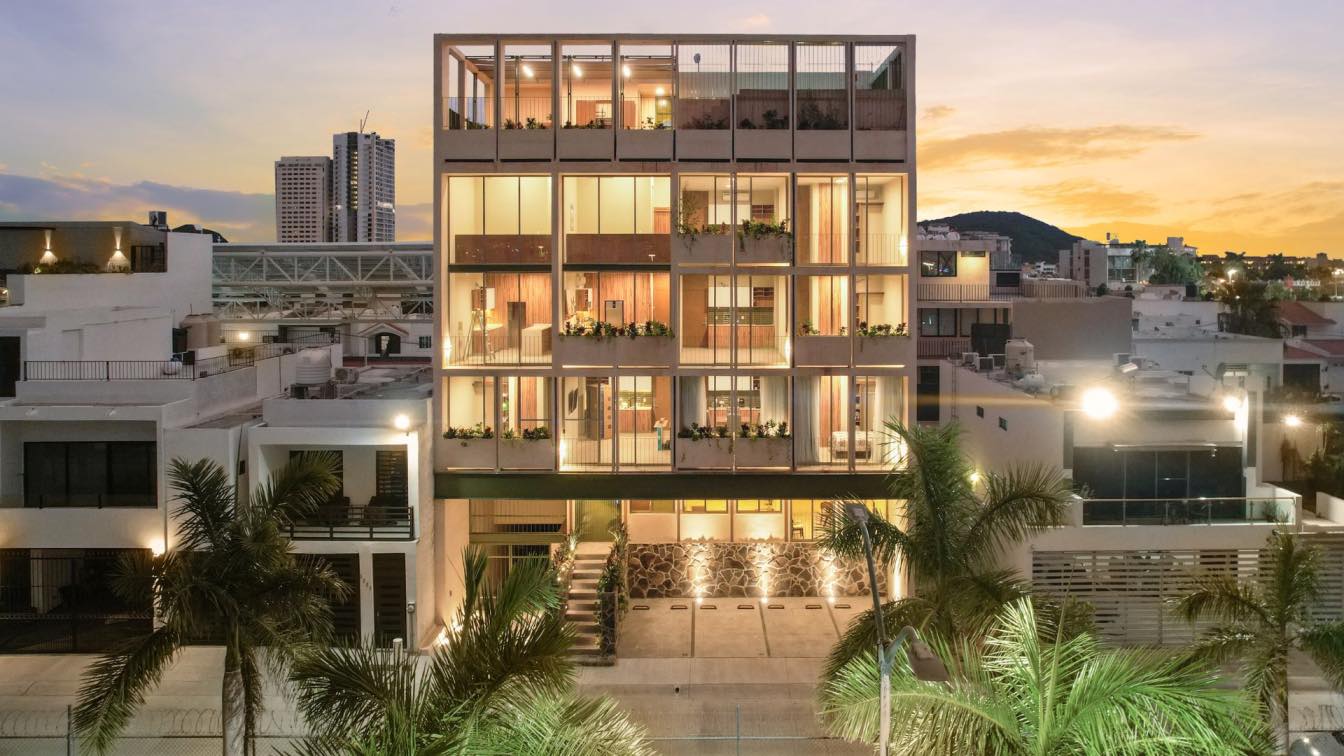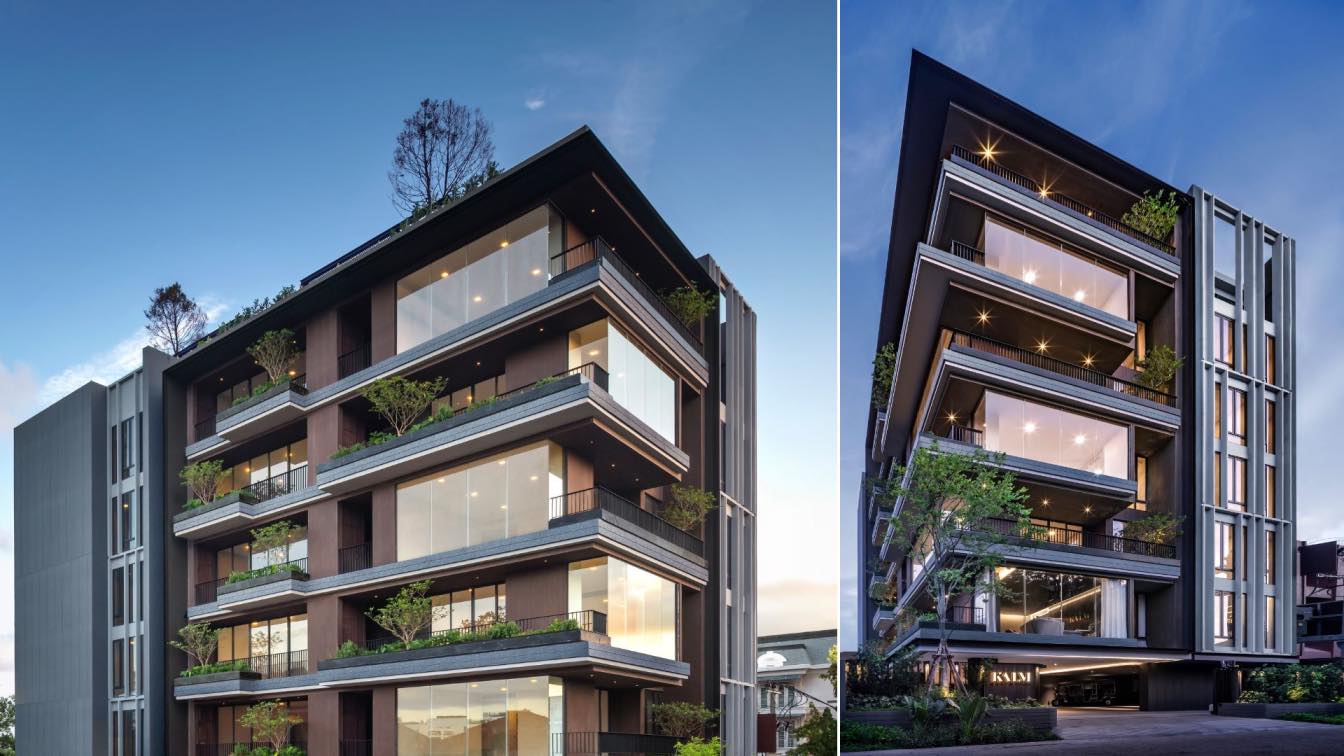Jonas is located at the harbor of Amsterdam IJburg and accommodates 190 medium-priced rental homes, 83 owner-occupied homes, and a range of supporting facilities. It’s a building with an innovative housing concept and spectacular spatial interior that received the highest possible sustainability certificate: BREEAM Outstanding. Jonas will enhance social cohesion, in what is still a new district, by creating a sustainable, inviting heart for the neighborhood. Orange Architects designed Jonas, with a mixed-use program, for Amvest in collaboration with ABT, Felixx Landscape Architects, Site Urban Development, and city maker Floor Ziegler. Ballast Nedam West was in charge of construction.
The name Jonas refers to the story of ‘Jonas and the Whale’. It stands for adventure and intimacy, but also for protection, shelter, and comfort inside a ‘big body’. It is a heroic building with a warm heart. But Jonas is also a sustainable and attractive building that stands out from the surrounding buildings in IJburg – if only because of the special site on the headland and the special program it accommodates. The building expresses in a striking manner themes that belong to this location: water, quayside, and the craft of shipbuilding. As a result, Jonas feels natural, because the building embraces the ‘soul of the place’ and renders it visible.

The building with its irregular openings creates the impression that the windows are gently undulating across the facade. That makes Jonas a bit different. It is not covered in stone but faced in dark, pre-patinated zinc. The facade does not touch the ground but is lifted off it. The volume is not rectangular but diamond-shaped. That makes it both familiar and alienating, sculptural yet rational, recognizable yet innovative.
But the real surprise of Jonas awaits inside. This is welcoming, warm, and spectacular. It expresses a modern and sustainable community life. The interior is unexpected and surrealistic. The spatial concept is based on the way traditional wooden ships are constructed: a skeleton consisting of a series of trusses arranged in a row, which form the main structure. This allows large hollows to be carved out of the volume, and the required housing program, a total of 273 apartments, is contained within the ‘skin’ of the building.
The landscape is not limited to the surroundings of the building but also penetrates deep into Jonas. A communal route, shaped as a canyon, extends through the building, linking together the public and collective program, including the living room, the cinema, the mountain path, the forest patio, and the rooftop beach and bar. The commercial facilities in the plinth, all supporting the concept and bigger picture of Jonas, provide extra dynamism on the ground floor and the quay. This part of the program is also accessible to the public. The residential concept of Jonas is supported by a community manager, who’s close to the residents and is to be consulted for matters like booking the guestrooms, the yoga studio, or a shared car. He is also responsible for organizing various activities together with residents and locals.

Jonas has a strong focus on communal living, with inclusiveness as one of the main goals. 70% of the 273 homes fall within the mid-rental category, making living in Jonas accessible to various target groups.
Besides the attention to social sustainability, Jonas is brimming with technically sustainable elements. The zero-energy building boasts a large number of solar panels on the roof. Sustainable energy is used for, among others, mechanical installations, and lighting systems. Moreover, a low-temperature heating system connects to the public heating grid. The cold storage source uses the nearby water: Thermal Energy from Surface Water (TEO). As a result, the homes can be both heated and cooled.
In addition to providing a future-proof energy supply, the design aims to reduce the use of materials and reuse raw materials. The environmental impact of materials was an important selection criterion, and the use of various raw materials was considered on multiple occasions during the process. The shadow price and carbon footprint of construction materials were constantly monitored and optimized. For example, the concrete is CSC certified, and at least a quarter of the granulate consists of recycled material, taken from construction waste for example. European Douglas wood is used both inside and outside.
The landscaping is nature-inclusive and is aimed at strengthening the ecological values of the area. For example, native riverside vegetation is planted. Moreover, mussel reefs are created in the water as a natural way of improving water quality and increasing biodiversity. A special feature to be built is a wall for sand martins. This species of bird belongs in this area but it is now under increasing pressure because of all the construction taking place. The sand martin wall will ensure that this species finds a home in the area again.

In addition to the measures to boost flora and fauna, Jonas wants to help in various ways to counter the effects of climate change. Rainwater, for example, is collected in the basement and reused to flush toilets in the public spaces and commercial units on the ground floor. The vegetation on the rooftop beach slows down water run-off. The moving water layer on the glass roof above the canyon provides for a pleasant experience of the rooftop beach and cools the glass in the summer. The patio, where a number of mature trees are planted in open ground, is a shaded place for contemplation, an extremely suitable spot in which to withdraw on a hot summer day.
Everything in Jonas is geared to stimulate social interaction and encounters to ensure the building becoming a focal point for activities and act as a catalyst for the neighborhood. Besides the technical sustainability, Jonas demonstrates that a green, healthy environment and social sustainability are essential principles, which are of the greatest importance for the success of the building and its surroundings.
























